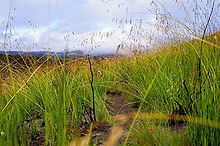- Pennisetum purpureum
-
Pennisetum purpureum 
Scientific classification Kingdom: Plantae (unranked): Angiosperms (unranked): Monocots (unranked): Commelinids Order: Poales Family: Poaceae Tribe: Paniceae Genus: Pennisetum Species: P. purpureum Binomial name Pennisetum purpureum
Schumach. 1827Pennisetum purpureum (Napier Grass or Uganda Grass) is a species of grass native to the tropical grasslands of Africa. It is a tall perennial plant, growing to 2–4.5 metres (6.6–14.8 ft) tall, rarely up to 7.5 metres (25 ft), with leaves 30–120 centimetres (12–47 in) long and 1–5 centimetres (0.39–2.0 in) broad.
The name Elephant grass derives from it being a favourite food of elephants.
Contents
Cultivation
Forage
It has a very high productivity as a forage grass for livestock and wildlife.
Biofuel
It can be killed with a light layer of frost but is usually harvested before winter so it can be burnt in power plants. It has a very high productivity as a biofuel crop.
Biological pest control
It has been proposed as a countermeasure to the corn borer in North America, since it attracts and traps the pest.[1] See Push-pull technology
Erosion control
It was planted in Kenya on artificial terraces helping to stop erosion, according to John Seymour.
Phytoremediation plant
ABC Science reports that "A team of Australian and Chinese scientists claims to have pioneered a method, using it as a Phytoremediation plant, to decontaminate polluted land and provide an ecologically renewable energy resource in the process." [2]
References
- ^ Dr. Ricarda Steinbrecher, testimony to Agriculture and Forestry Committee of Senate of Canada, 5 December 2006
- ^ Grass could turn toxic waste into energy
- FAO Animal Feed Resources Information System: Pennisetum purpureum
- FAO: Pennisetum purpureum
- Tropical Forages: Pennisetum purpureum
External links
 Data related to Pennisetum purpureum at Wikispecies
Data related to Pennisetum purpureum at WikispeciesThis Panicoideae article is a stub. You can help Wikipedia by expanding it.
